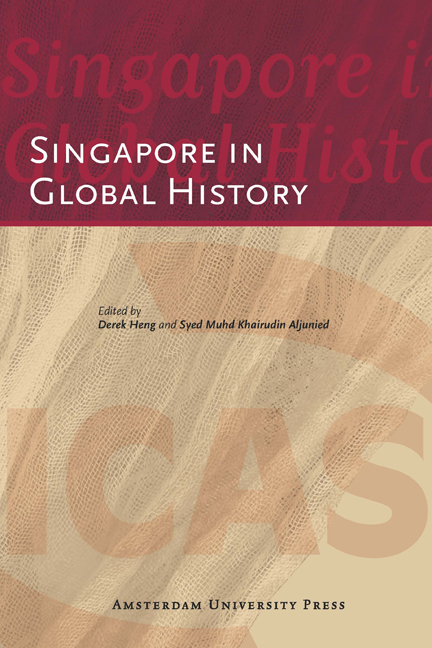Book contents
- Frontmatter
- Contents
- List of Tables and Illustrations
- Foreword
- 1 Globalising the History of Singapore
- 2 Situating Temasik within the Larger Regional Context: Maritime Asia and Malay State Formation in the Pre-Modern Era
- 3 The Singapore River/Port in a Global Context
- 4 ‘Walls of Illusion’: Information Generation in Colonial Singapore and the Reporting of the Mahdi-Rebellion in Sudan, 1887-1890
- 5 The Littoral and the Literary: Making Moral Communities in the Straits Settlements and the Gold Coast in the late Nineteenth and Early Twentieth Century
- 6 Social Discourse and Economic Functions: The Singapore Chinese in Japan’s Southward Expansion between 1914 and 1941
- 7 The Dynamics of Trans-Regional Business and National Politics: The Impact of Events in China on Fujian-Singapore Tea Trading Networks, 1920-1960
- 8 Rambutans in the Picture: Han Wai Toon and the Articulation of Space by the Overseas Chinese in Singapore
- 9 The Global Effects of an Ethnic Riot: Singapore, 1950-1954
- 10 The British Military Withdrawal from Singapore and the Anatomy of a Catalyst
- 11 Bringing the International and Transnational back in: Singapore, Decolonisation, and the Cold War
- 12 The Global and the Regional in Lee Kuan Yew’s Strategic Thought: The Early Cold War Years
- 13 A Brief History of the Hub: Navigating between ‘Global’ and ‘Asian’ in Singapore’s Knowledge Economy Discourse
- About the Contributors
- Bibliography
- Miscellaneous Endmatter
3 - The Singapore River/Port in a Global Context
Published online by Cambridge University Press: 02 February 2021
- Frontmatter
- Contents
- List of Tables and Illustrations
- Foreword
- 1 Globalising the History of Singapore
- 2 Situating Temasik within the Larger Regional Context: Maritime Asia and Malay State Formation in the Pre-Modern Era
- 3 The Singapore River/Port in a Global Context
- 4 ‘Walls of Illusion’: Information Generation in Colonial Singapore and the Reporting of the Mahdi-Rebellion in Sudan, 1887-1890
- 5 The Littoral and the Literary: Making Moral Communities in the Straits Settlements and the Gold Coast in the late Nineteenth and Early Twentieth Century
- 6 Social Discourse and Economic Functions: The Singapore Chinese in Japan’s Southward Expansion between 1914 and 1941
- 7 The Dynamics of Trans-Regional Business and National Politics: The Impact of Events in China on Fujian-Singapore Tea Trading Networks, 1920-1960
- 8 Rambutans in the Picture: Han Wai Toon and the Articulation of Space by the Overseas Chinese in Singapore
- 9 The Global Effects of an Ethnic Riot: Singapore, 1950-1954
- 10 The British Military Withdrawal from Singapore and the Anatomy of a Catalyst
- 11 Bringing the International and Transnational back in: Singapore, Decolonisation, and the Cold War
- 12 The Global and the Regional in Lee Kuan Yew’s Strategic Thought: The Early Cold War Years
- 13 A Brief History of the Hub: Navigating between ‘Global’ and ‘Asian’ in Singapore’s Knowledge Economy Discourse
- About the Contributors
- Bibliography
- Miscellaneous Endmatter
Summary
There is little question that Singapore in the twenty first century is a global city that is heavily dependent on international economic forces for its existence, success and even failure into the future. Singapore meets many of the criteria to qualify for global city classification (Sassen 1991). At the same time it is also quite unique compared with other cities that might make similar claims. It is an island city state with no natural resources (beyond the much vaunted resource of its people), dependent on its neighbours and the global community for even the most basic commodities necessary for human survival, especially food and water. This dependence and connectedness with a wider global environment is not a recent phenomenon. Over the past couple of decades, debate about globalisation, what it is and what it means has often obscured the fact that interconnectedness and flows in terms of trade, culture, religion and politics have long been a ‘global’ reality (Frank 1998). In the context of Singapore there is little doubt that in pre-modern times, such as during the Temasik and Singapura periods, it was already linked to various international trade, political and cultural networks by virtue of its place in the realms of the great regional kingdoms of Srivijaya and Majapahit, as testified to by various archaeological artefacts and documentary sources that have been uncovered (Murfett 1999). Raffles arrival at Singapore on the 28th of January 1819 marked the beginning of another phase of global interconnectedness for the island as it took its place in modern history and became inextricably linked to and dependent on new global forces and waves of change. This chapter examines how the settlement and port of the island evolved along the Singapore River, linking the island to an international capitalist system and trading network during the first five decades after Raffles arrived. The changes brought about by this integration with a new global system would ultimately see Singapore become a prosperous home for millions of migrants from around the Asian region and the wider world. The same forces that shaped modern Singapore would see the world transformed ultimately from one of European hegemony, achieved via imperialism/colonialism, in terms of political and economic power, between the mid-nineteenth and twentieth centuries to one of independent nation states loosely bound together by structures and dependencies created in the previous century.
- Type
- Chapter
- Information
- Singapore in Global History , pp. 51 - 66Publisher: Amsterdam University PressPrint publication year: 2012



